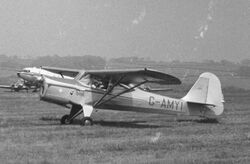Engineering:Auster Aiglet Trainer
From HandWiki
Short description: 1950s British light aircraft
| J/5 Aiglet Trainer | |
|---|---|

| |
| Role | Aerobatic trainer/tourer |
| Manufacturer | Auster Aircraft Limited |
| First flight | 1951 |
| Primary users | private pilot owners Pakistan Air Force |
| Produced | 1951-1958 |
| Number built | 77 |
| Developed from | Auster J/5 Autocar |
| Variants | Auster J/5R Alpine |
The Auster J/5 Aiglet Trainer was a 1950s United Kingdom single-engined four-seat high-wing training and touring monoplane built by Auster Aircraft Limited at Rearsby, Leicestershire.
History
Despite its name, the aircraft type had nothing to do with the Auster J/1B Aiglet, it being an aerobatic development of the Auster J/5 Autocar.
The Aiglet Trainer was based on the J/5 fuselage with new wings and stressed for aerobatics. The prototype first flew on 2 June 1951.
Most Aiglet Trainers were bought by private pilots and flying clubs, but 15 went to the Pakistan Air Force, 14 to the Iran Civil Aviation Club and two to the Lebanese Air Force.[1]
Variants
- Auster J/5F Aiglet Trainer – production version.
- Auster J/5K Aiglet Trainer – Blackburn Cirrus Major 3 engine, one built.
- Auster J/5L Aiglet Trainer – de Havilland Gipsy Major 1 engine. 10 built.
- Auster J/8L Aiglet Trainer – J-5K re-engined with a de Havilland Gipsy Major 1 engine.
Operators
![]() Jordan
Jordan
 Lebanon
Lebanon
- Lebanese Air Force – two aircraft[3]
 Pakistan
Pakistan
- Pakistan Air Force – 17 aircraft[3]
Specifications (J/5F)
Data from Jane's All The World's Aircraft 1955–56[4]
General characteristics
- Crew: 2 or 3
- Length: 23 ft 2 1⁄2 in (7.074 m)
- Wingspan: 32 ft 0 in (9.75 m)
- Height: 8 ft 3 in (2.51 m)
- Wing area: 164 sq ft (15.2 m2) [5]
- Empty weight: 1,323 lb (600 kg)
- Max takeoff weight: 2,200 lb (998 kg) (three seater)
- Powerplant: 1 × de Havilland Gipsy Major 1 4-cylinder inline engine, 130 hp (97 kW)
Performance
- Maximum speed: 127 mph (204 km/h, 110 kn)
- Cruise speed: 110 mph (180 km/h, 96 kn)
- Stall speed: 29 mph (47 km/h, 25 kn) full flaps, engine off
- Range: 275 mi (443 km, 239 nmi)
- Service ceiling: 12,500 ft (3,800 m) [5]
- Rate of climb: 705 ft/min (3.58 m/s)
References
- Notes
- ↑ Ellison, 1966, pp. 61-64
- ↑ Flight 13 May 1955, p. 648.
- ↑ Jump up to: 3.0 3.1 Ellison 1965, pp. 47-50
- ↑ Bridgman 1955, p. 51.
- ↑ Jump up to: 5.0 5.1 Jackson 1974, p. 81.
- Bibliography
- Bridgman, Leonard (1955). Jane's All The World's Aircraft 1955–56. New York: McGraw-Hill Book Company.
- Ellison, N.H. (1965). Auster Aircraft - Aircraft Production List. N.H. Ellison for Air-Britain (Historians) Ltd.
- Ellison, N.H. (1966). Auster Aircraft. Air-Britain (Historians) Ltd.
- Hitchman, Ambrose (1989). The History of the Auster Aeroplane. International Auster Pilot Club.
- The Illustrated Encyclopedia of Aircraft (Part Work 1982-1985). Orbis Publishing.
- Jackson, A.J. (1974). British Civil Aircraft since 1919 Volume 1. London: Putnam. ISBN 0-370-10006-9.
- "The World's Air Forces: Their Composition, Duties and Aircraft". Flight 67 (2416): 615–668. 13 May 1955. https://www.flightglobal.com/pdfarchive/view/1955/1955%20-%200615.html.
External links
 |


